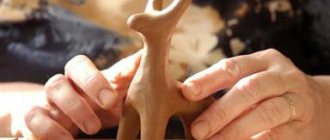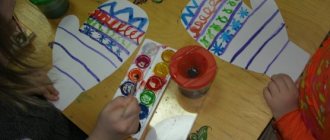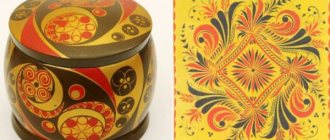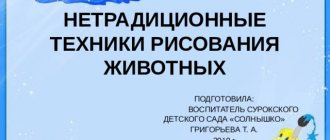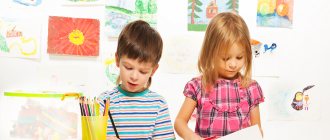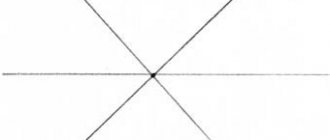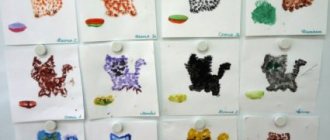Set of educational cards “Dymkovo Fairy Tale”.
Set of educational cards “Dymkovo Tale”
Rugacheva Olesya Vladimirovna,
teacher of the highest qualification category
Explanatory note
Educational area:
artistic and aesthetic development (visual activity).
Topics reflected in the cards:
elements of Dymkovo painting; color variety of painting elements; the difference between Dymkovo painting and Gorodets painting; material necessary for making the Dymkovo toy; elements of Khokhloma, Gorodets and Zhostovo ornaments.
Age:
children 5-7 years old (senior preschool age).
Type of lesson:
studying, consolidating and systematizing the material.
Child knowledge and skills required for work:
knowledge of the history of the Dymkovo toy; the ability to name the species diversity of toys; knowledge of painting elements; the ability to distinguish Dymkovo painting from Gorodets, Khokhloma and Zhostovo; ability to compare, analyze and reason.
Expected results:
consolidation and systematization of knowledge about Dymkovo painting; developing the ability to distinguish it from other types of painting; developing the ability to create your own ornament when working with a Dymkovo toy, selecting appropriate colors and elements.
Material:
laminated cards measuring 11*16 cm (10 pieces), a damp cloth, felt-tip pens of different colors.
Instructions for using cards
1. “Which toy is the odd one out? Why?"
Goal: to consolidate the ability to find a Dymkovo toy based on the elements of the painting.
Procedure: invite the children to carefully examine the card and circle the extra toy, explain their decision, name all types of painting (the extra one is a wooden horse in Gorodets painting).
Time allotted for working with the card: 3-4 minutes.
2. “What patterns will we decorate the lady with?”
Goal: to consolidate the ability to select elements of the Dymkovo ornament.
Procedure: invite the children to carefully examine the card and use arrows to connect the lady with the ornamental elements used by the Dymkovo masters. Explain your decision, name all types of painting (Khokhloma, Dymkovo, Gorodets, Zhostovo).
Time allotted for working with the card: 3-4 minutes.
3. “Repeat the pattern”
Goal: to strengthen the ability to draw elements of Dymkovo painting.
Procedure: invite children to carefully examine the elements of the painting and repeat them according to the model.
Time allotted for working with the card: 3-4 minutes.
4. “Find your soulmate”
Goal: to consolidate the ability to find the other half of a toy.
Procedure: invite the children to carefully examine the card and use arrows to connect the halves of the Dymkovo toys.
Time allotted for working with the card: 3-4 minutes.
5. “What color should we paint the toy?”
Goal: to consolidate the ability to select colors for Dymkovo painting.
Procedure: invite the children to carefully examine the card and use an arrow to connect the toy with a geometric figure of the color that the craftsmen used to paint Dymkovo toys (all colors on the card are suitable).
Time allotted for working with the card: 3-4 minutes.
6. “What is the toy made of?”
Goal: to consolidate the ability to find and name the material necessary for making a Dymkovo toy.
Procedure: invite children to carefully examine the card and use an arrow to connect the toy with the material used to make it. Explain your decision, name all types of materials (paper, fabric, clay, woolen threads, wooden boards).
Time allotted for working with the card: 3-4 minutes.
7. “What should we decorate the horse with?”
Goal: to consolidate the ability to select types of Dymkovo painting ornaments that were used to decorate a horse.
Procedure: invite the children to carefully examine the card and use an arrow to connect the toy with the types of ornaments that are used to paint the horse. Explain your decision, name all types of ornaments and their use (the lady’s skirt was decorated with a cage and a wave).
Time allotted for working with the card: 3-4 minutes.
8. “Name the toy”
Goal: to consolidate the ability to recognize and name the main types of Dymkovo toys.
Procedure: invite the children to carefully look at the card and name all the toys (rider, turkey, horse, lamb, water carrier, bird).
Time allotted for working with the card: 3-4 minutes.
9. “Complete the pattern”
Goal: to consolidate the ability to complete the elements of Dymkovo painting.
Procedure: invite children to carefully examine the elements of the painting and complete them according to the model.
Time allotted for working with the card: 3-4 minutes.
10. “Color the pattern”
Goal: to consolidate the ability to paint elements of Dymkovo painting according to plan.
Procedure: invite children to carefully examine the elements of the painting and color them according to plan.
Time allotted for working with the card: 3-4 minutes.
Dymkovo fairy tale DOCX / 2.3 MB
Progress of the lesson:
- Let's sit next to each other and talk well. I wanted to tell you guys an amazing story. In a certain kingdom of the Russian state, on the bank of a river stood, and still stands, the large village of Dymkovo . Why is it called that? In the old days, in winter, when the stoves were heated, and in summer, when the fog rose from the river, the village seemed to be shrouded in haze . Here, in ancient times, the toy was born, which was called “ Dymkovskaya ”
. On long winter evenings they sculpted those toys from clay.
All toys are not simple,
Snow-white, like birch trees,
A seemingly simple pattern
But I can't take my eyes off
The toys made by Dymkovo craftsmen turned out to be unusually beautiful, bright, fabulous, and magical. People believed that these toys protected them from misfortunes and troubles. Therefore, they were placed between the windows in winter and decorated with toys at home.
Let's look at Dymkovo toys . What elements are they painted with?
(circles, circles, lines)
(Red, blue, green, yellow, black)
Each color had its own meaning among folk craftsmen. For example, white is the color of purity, and red was associated with the sun. Please note that each toy has a background when painted. On what background are all the circles, ovals, lines, and crosses written?
White color gives toys a bright, elegant and festive look.
Children look at the slides together with the teacher.
- And now I want to invite you guys to a creative workshop. Do you want to become master craftsmen and also paint a Dymkovo toy ?
The guys go to the tables. The teacher shows techniques for painting a Dymkovo young lady . Shows children various elements of Dymkovo painting and invites children to engage in creativity on their own.
At the end of the lesson, the guys and the teacher line up the young ladies in a round dance . They choose which one they like. They discuss what was interesting in the lesson and what was difficult.
Abstract of educational activities on modeling based on the Dymkovo toy in the senior group “Young Lady” MBDOU DS No. 35 “Rucheyok” Tuapse Abstract of complex direct educational activities on modeling topic: “Young Lady” (based on.
Abstract of GCD Decorative drawing “Painting a goat sculpted after a Dymkovo toy”, senior group • Topic: “Painting a goat sculpted after a Dymkovo toy • Purpose: To teach children to paint a sculpted figure according to folk (Dymkovo) patterns.
Dymkovo horse
Municipal preschool educational institution "Nursery-kindergarten of a combined type No. 352 in Donetsk"
Lesson summary “Dymkovo horse” (decorative drawing)
Middle group
Responsible: Zadvornaya I.N., teacher of the second qualification category
Date: 07.12.2020
Target
: to form children’s interest in Russian folk art, to cultivate patriotic feelings - respect for folk traditions, pride in their people.
Tasks:
Educational:
continue to introduce children to the Russian folk toy - the Dymkovo horse;
develop skills in comparing modern and folk toys, the ability to identify their distinctive features;
promote the development of speech, attentiveness, and observation when describing toys;
expand children's knowledge about folk toys, the features of Dymkovo toys (material, types of patterns, color variety), teach them to identify patterns familiar to children and see their beauty.
Educational:
develop children's creative abilities through exposure to folk art and applied arts;
continue to develop the ability to apply patterns in the form of circles and lines on the image of a horse, navigate the sheet, and perform the work sequentially in two stages.
Educational:
cultivate a love of folk art;
develop a caring, sensitive attitude towards toys;
promote patriotic education of children,
instill a sense of pride in our people.
Materials and equipment:
table, magnetic board, magnets, parcel with a Dymkovo toy, a letter, a plastic toy horse, illustrations of “Dymkovo toys”, samples of step-by-step drawing “Dymkovo horse”; album sheets with images of Dymkovo horses (according to the number of children), gouache paints of different colors, cups of water, brushes, mats, napkins, stands for brushes.
1. Organizational moment
Surprise moment
Educator:
Guys, look, today a package arrived at the kindergarten. Examination of the parcel.
Game “Guess who the package is from?”
— Guys, who do you think could send us the package? (Santa Claus, bear, friends, fairy, snowman, etc.)
The teacher reads the sender's address on the parcel (Russia, Dymkovo settlement), as well as the recipient's address (Donetsk city, Kalinka kindergarten, Bees group). This means the package has been sent to us, you can open it. - Guys, I don’t know who sent the package.
Opening the package: What do you think they might have sent us in the package? (Toys, gifts, candies, balls, pencils, books).
